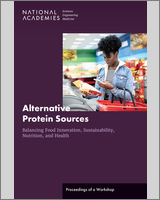NCBI Bookshelf. A service of the National Library of Medicine, National Institutes of Health.
Alternative protein sources, which can be derived from plant and animal cells or created by precision fermentation, can have health, environmental, socio-economic, and ethical impacts. With a variety of types of alternative proteins being developed and available on the market, consumers, regulatory agencies, manufacturers, and researchers are faced with many different considerations. The National Academies Food Forum hosted a workshop that took a multi-sector approach to explore the state of the science on alternative protein sources as they relate to issues around diet quality, nutrition, and sustainability. The workshop also examined how alternative protein food processing innovations can be balanced in a way that optimizes nutritional content, affordability, and accessibility. This Proceedings of a Workshop summarizes the discussions held during the workshop.
Contents
- The National Academies of SCIENCES • ENGINEERING • MEDICINE
- PLANNING COMMITTEE FOR A WORKSHOP ON ALTERNATIVE PROTEIN SOURCES: BALANCING FOOD INNOVATION, SUSTAINABILITY, NUTRITION, AND HEALTH
- FOOD FORUM (AS OF AUGUST 2022)
- Reviewers
- 1. Introduction
- 2. Current Protein Challenges
- THE ROLE OF PROTEIN IN THE DIET
- HEALTH AND NUTRITIONAL IMPACTS OF INCREASING ALTERNATIVE PROTEIN INTAKE IN THE DIET
- DISCUSSION
- ENVIRONMENTAL IMPACTS OF INCREASING ALTERNATIVE PROTEIN INTAKE IN THE DIET
- SOCIOECONOMIC IMPACTS OF INCREASING ALTERNATIVE PROTEIN INTAKE IN THE DIET
- THE ETHICS OF ALTERNATIVE PROTEINS: TECHNOLOGY, ANIMALS, AND SUSTAINABILITY
- DISCUSSION
- 3. Implications for the Industry, Consumers, and Regulators
- INDUSTRY IMPLICATIONS OF ALTERNATIVE PROTEIN PRODUCTS
- PLANT-BASED ALTERNATIVES AS TRANSITION AND MAINTENANCE FOODS
- CONSUMER PERSPECTIVES ON ALTERNATIVE PROTEIN PRODUCTS
- SAFETY PERSPECTIVES ON ALTERNATIVE PROTEIN PRODUCTS
- REGULATORY DECISION-MAKING TOOLS FOR NOVEL FOOD TECHNOLOGIES
- REQUIREMENTS FOR LABELING OF ALTERNATIVE PROTEIN FOODS
- DISCUSSION
- 4. Balancing Innovation in Alternative Protein Processing with Sustainability, Health, Affordability, and Accessibility
- THE ALTERNATIVE PROTEIN LANDSCAPE
- PLANT-BASED FOOD DESIGN, PRODUCTION, AND PROPERTIES
- CELL-BASED AND CULTURED MEATS
- DISCUSSION
- FORMULATION AND PROCESSING CONSIDERATIONS IN DEVELOPING ALTERNATIVE PROTEIN PRODUCTS
- FOOD PROCESSING AND PROTEIN QUALITY CONSIDERATIONS
- DEVELOPING ALTERNATIVE DAIRY PRODUCTS
- INSECTS AS A PROTEIN SOURCE
- DISCUSSION
- DISCUSSION WITH PLANNING COMMITTEE MEMBERS
- References
- Appendix A. Workshop Agenda
- Appendix B. Acronyms and Abbreviations
- Appendix C. Biographical Sketches of Workshop Speakers and Planning Committee Members
Suggested citation:
National Academies of Sciences, Engineering, and Medicine. 2023. Alternative protein sources: Balancing food innovation, sustainability, nutrition, and health: Proceedings of a workshop. Washington, DC: The National Academies Press. https://doi.org/10.17226/26923.
Digital Object Identifier: https://doi.org/10.17226/26923
This publication is available from the National Academies Press, 500 Fifth Street, NW, Keck 360, Washington, DC 20001; (800) 624-6242 or (202) 334-3313; http://www.nap.edu.
Printed in the United States of America.
- NLM CatalogRelated NLM Catalog Entries
- Alternative Protein SourcesAlternative Protein Sources
Your browsing activity is empty.
Activity recording is turned off.
See more...
